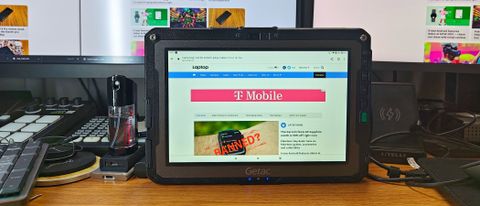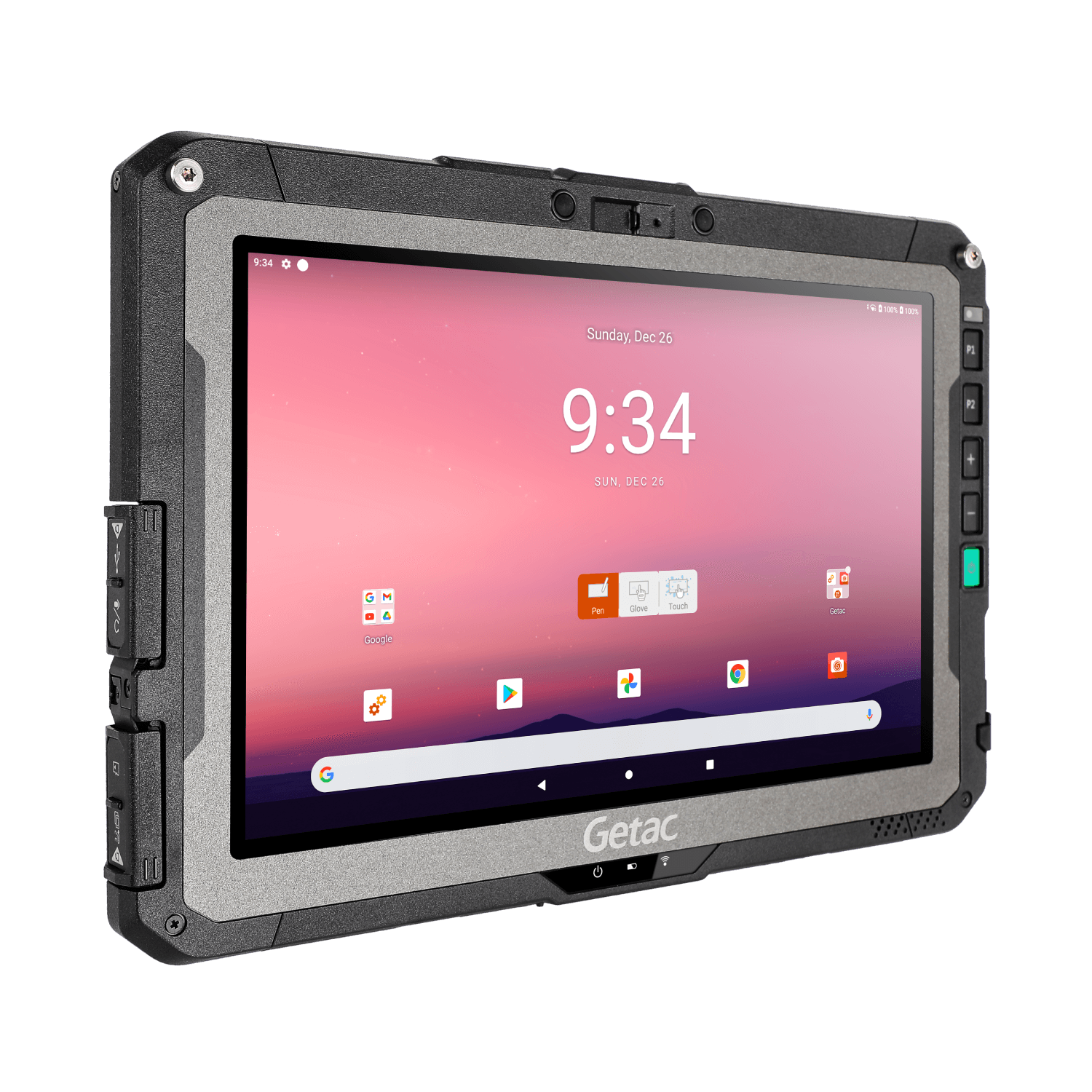Snappy performance hides behind a robust, sturdy shell that delivers in harsh conditions.

Laptop Mag Verdict
If you’re in the market for a rugged field tablet, the Getac ZX10 is an excellent choice. With perky performance and a daylight-readable display making it perfect for first responders and those in construction.
Pros
- Rugged, durable build quality
- Readable in daylight display
- Almost 24-hour battery life
- Speedy performance
Cons
- You pay a premium for extreme durability
- Weak audio
Why you can trust Laptop Mag Our expert reviewers spend hours testing and comparing products and services so you can choose the best for you. Find out more about how we test.
CPU: Qualcomm Snapdragon SD660
RAM: 4GB
Storage: 64GB eMMC
Display: 10.1 inch (1920 x 1200)
Battery: 21:51
Size: 10.8 x 7.6 x 0.7 inches
Weight: 2.29 pounds
Getac is synonymous with rugged devices. The ZX10 keeps the bloodline flowing as a rough-and-tumble Android tablet for first responders, construction workers, or anyone in a field that requires something tougher. The Getac ZX10 is a robustly built, dual-battery Android tablet that I doubted, but thanks to smooth, reliable performance, it has become one of my favorites.
If you work in the field (construction, medicine, military, etc.), you require something hardy that will handle harsh working environments, dirt, drops, and nasty weather, while still offering reliable performance, and Getac delivers all of this with the ZX10. However, it’s seriously expensive compared to regular tablets. It’s not meant for average consumers; it’s a warrior for those needing additional armor and strength.
Getac ZX10 pricing and configurations
The Getac ZX10 I reviewed comes with a Qualcomm Snapdragon SD660 CPU, 4GB of RAM, and 64GB of eMMC storage, which costs $1,985.99.
Obviously, you’re paying for the ruggedness and weatherproofing, but remember this is a tablet meant for those in the field. The internal specs are comparable to a mid- to low-end Android tablet, so the cost is entirely driven by the ability of this tablet to survive in just about any environment.
Getac ZX10 design
The Getac ZX10 looks and feels like an indestructible black polymer plastic slab. A thick, solid magnesium alloy frame extends over the outer hard plastic shell. On its front, the display is recessed, presumably to offer protection from direct impact.

The stylus and batteries are also recessed on its back. Dozens of exposed small Philips screws secure it all together and give it an appropriately industrial look.

Like Getac rugged laptops we reviewed, I threw it around and soaked it under the faucet, and it was fine. The ZX10 is IP66-rated, and MIL-STD-810H certified. It is built to handle dust, dirt, wet conditions, and drops of up to six feet. IP66 means that it will handle a direct hit from a hose or any level of precipitation, but it isn’t designed to be submerged completely.

On the right side of the screen (when held horizontally), there’s a row of five buttons topped by a light sensor that measures the ambient light and adjusts the display’s brightness accordingly. Two of the four buttons are labeled “P1” and “P2,” they are programmable: by default, they decrease and increase the brightness. The other two buttons are labeled “+” and “-” and, by default, control the volume, but they, too, are programmable. The final and fifth button is the green colored power button.
Below the screen are LEDs that indicate power on, Wi-Fi activity, and battery status (amber when charging, green when fully charged, and various flashing status messages). There are eyelets for a vehicle mount on the lower edge, while a sturdy carrying handle can be attached to the upper edge.
Measuring 10.8 x 7.6 x 0.7 inches and weighing 2.29 pounds, the ZX10 is husky for a reason, as it will survive the beating your average tablet will not. Our comparison tablet, the Lenovo Tab P11 Pro Gen 2, measures 10.36 x 6.56 x 0.26 inches and weighs in at 1.05 pounds.
Getac ZX10 security
A webcam shutter provides security when you’re done with video calls and keeps prying eyes out.

Additionally, you have a Kensington lock if you need to secure the tablet on-site. An optional HF RFID/NFC combo reader or Smart card reader can be added to the tablet, but were not present on our review unit.
Getac ZX10 ports
The ZX10 has five ports, all sealed behind thick plastic doors that slide and click into place. On the left, you will find behind the mid door a USB Type-A port and a 3.5mm audio jack when held horizontally.

Below, behind the second door, you will find a USB-Type C port and a MicroSD card slot.

On the bottom right, you find a thick rubber door that, when flipped open, reveals the power port.
Getac ZX10 display
The ZX10’s screen is a 10.1-inch LumiBond (durability process) TFT display panel with a WUXGA resolution (1920 x 1200) rated at a maximum of 800 nits of brightness. This, along with Getac’s sunlight readability technology, makes it suitable for viewing in various conditions. The screen features a three-button touch panel that allows you to choose between gloved, finger, or stylus input for maximum touchscreen responsiveness. The screen’s matte finish helps with outdoor legibility and good viewing angles.
I launched YouTube to watch the Guardians of the Galaxy Vol. 3 trailer. Although the matte finish slightly affects the image by flattening out the colors, overall, it’s a solid viewing experience with crisp, sharp videos and images. The colors were nicely saturated, as you can see in the photo of our gang of Galaxy-hopping do-gooders looking lovely in their orange prison jumpsuits.

We put a colorimeter on the display to test it and found that it reproduced 48.7% of the DCI-P3 color spectrum, which falls below the 81.1% category average. During the same test, the Lenovo P11 Pro scored 118.2% of the DCI-P3 color spectrum.
Next, we tested the brightness and found it averaged a nifty 790 nits with adaptive brightness off and 795 nits with adaptive brightness turned on, so it’s plenty bright, surpassing the tablet’s average 368.3 nits.
Our comparison tablet, the P11 Pro, averaged 416 nits with adaptive brightness off and 560 nits with adaptive brightness on.
Getac ZX10 audio
You will find a speaker grille at the bottom right corner of the tablet’s display frame. The audio output is not the best, but I wasn’t expecting this to turn into a boombox. The audio is clear but not very loud, lacking depth and bass. You may have trouble hearing someone during video calls. I would suggest checking out a pair of wireless earbuds or noise cancelling headphones on their respective best pages.
Getac ZX10 performance
Overall, I found the Getac ZX10’s performance snappy and smooth. I opened up Google Chrome and started browsing, opened up 20 tabs, with two playing videos, and it never lagged or bogged down. I opened up a Google Doc and started typing, and everything ran smoothly.
Apps started up quickly and were highly responsive, which first responders need when in the field. Nobody wants a tablet that is bogged down when trying to input a patient’s vitals.
During Geekbench 5.0, a synthetic overall performance test, the ZX10’s Snapdragon 660 processor scored 1,450 in the multicore benchmark. This was below the category average of 1,633. Our Lenovo P11 Pro, with its MediaTek Kompanio1300T CPU, scored 2,790 during this benchmark.
Getac ZX10 battery life
With a dual-battery setup, I was pretty sure the ZX10 would have excellent battery life, and it didn’t disappoint. During our testing, which consisted of continuous web surfing over Wi-Fi at 150 nits, the ZX10 lasted 21 hours and 51 minutes, which leaps past the 11-hour and 46-minute category averages. So, we’re talking nearly 24 hours of battery life for a true all-day use experience. The tablet battery life average is 11 hours and 46 minutes, but most tablets only possess one battery, whereas the ZX10 has two hot-swappable batteries you can switch out if need be.
The Lenovo Tab P11 Pro averaged 10:12 of battery life during our testing. However, it only has one battery.
During my regular daily use, I would get a few days from a single charge since I was browsing the web or watching YouTube videos and then putting the unit down.
Getac ZX10 Chromebook webcam
Above the screen is the 8-megapixek webcam with a sliding privacy shutter for when the camera isn’t in use. Because the Getac ZX10 is designed to be used by those wearing gloves, the privacy cover has a significant lip for easy sliding. On the rear, there is a 16-megapixel rear camera with an LED flash that lacks a security cover. Getac’s camera software offers digital zoom of up to 7.7x for both cameras, allows you to adjust resolution, and use the flash.

I found images to be solid and more than adequate if you need to take a photo while working in the field and share it with someone. The video capabilities are also solid, with good skin tone reproduction during video calls.
Getac ZX10 software and warranty
The Getac ZX10 comes with Android 11 pre-installed and runs very smoothly. Getac does have a set of proprietary apps like its bespoke camera app, a device management tool, and the usual assortment of Google apps such as Chrome, Google Meet, and YouTube. Getac also offers security updates for the ZX10 until January 2027.
Getac offers what they refer to as a three-year bumper-to-bumper warranty which covers accidental damage that happens under normal conditions.
Bottom line
The Getac ZX10 is a rugged tablet that is heavy on the rugged and not something a typical consumer should consider for everyday use. Due to its extremely durable build quality, and unique features like its display that caters to gloved usage, you will pay a premium.
So if your work requires a tablet that can survive in almost any condition, the Getac ZX10 is an excellent choice and will not disappoint.


